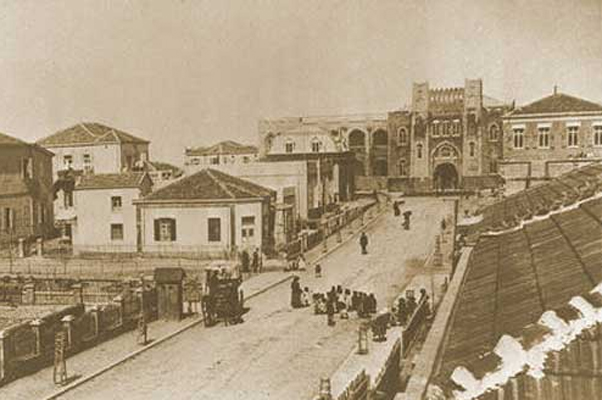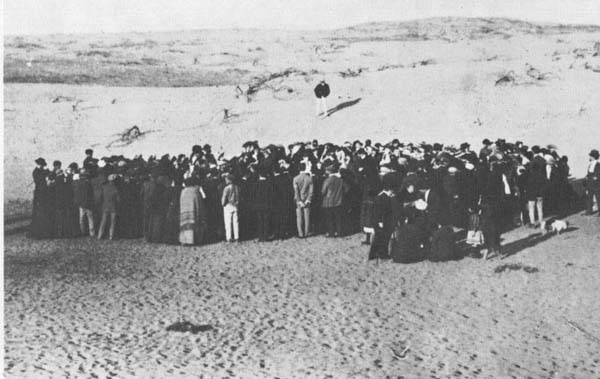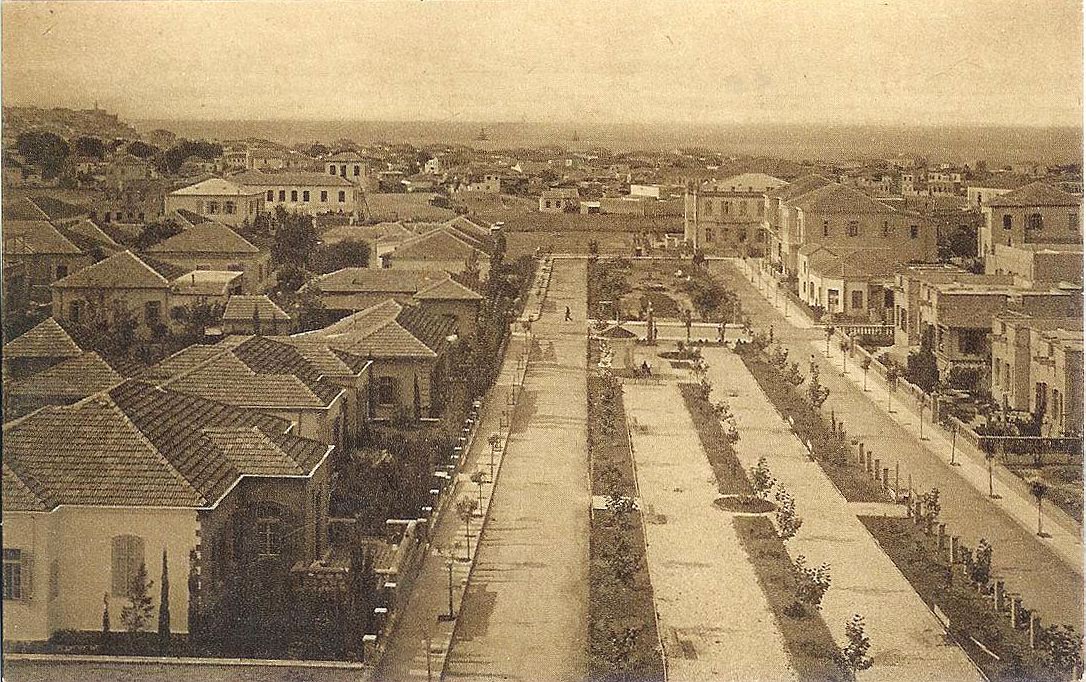Jacobus Henricus Kann
Scrupulous Banker, Enlightened Dutchman, Moderate Zionist
Chaya Brasz ©
This article on Jacobus Henricus Kann is the extended text of a lecture held by Chaya Brasz in Beth Dizengoff in Tel Aviv, on 1st June 2009, celebrating the 100th anniversary of Tel Aviv. The event was initiated and organized by the Irgun Oleh Holland in cooperation with the Netherlands Embassy in Israel. [English editing of the article: Rachele Liberman]. Chaya Brasz is a professional historian, specialized in the history of the Jews in the Netherlands and of Dutch Jews in Israel. She studied at the State University of Utrecht and the Hebrew University of Jerusalem. Her thesis on the Jewish community in Culemborg earned her the Hartog Beem prize in 1982. She lives in Jerusalem and is the former director of the Center for Research on Dutch Jewry at the Hebrew University, where she worked for sixteen years. Among her most wellknown publications are: De Kille van Kuilenburg (Culemborg 1984); Removing the Yellow Badge, the Struggle for a Jewish Community in the Postwar Netherlands, 1944-1955 (Jerusalem 1995) and the chapter on the postwar period in the standardwork The History of the Jews in the Netherlands (Oxford 2002).
Jacobus Kann, the banker from The Hague in the Netherlands, is finally recognized as the original purchaser of the land on which Tel Aviv was founded. The approval for the purchase may have been given far away – in The Hague – but in the history of Tel Aviv, there is no more denying that this Dutchman was instrumental in the realization of one of Herzl’s dreams.[1] Moreover, Kann played an active role in the international Zionist Movement for over 20 years, and his influence lasted even longer. The time has come now to share some of his biography with the wider public in Israel and the residents of Tel Aviv-Yafo in particular.
When Kann purchased the dunes known as ‘Kerem Jabali’, north of Yafo, he had never actually seen them. But in April 1909, when the famous ‘lottery of plots’ was held among the members of the ‘Ahuzat Bayit’ association, he was no longer a foreigner. Kann visited Eretz Israel for the first time in 1907, while it was still part of the Turkish Empire. He arrived in Yafo on a steamship from Port Said. In those days there was no harbor, and passengers were brought ashore in large rowing boats. The sea was rough and Kann was seasick: “My legs failed me,” he wrote. “I felt so ill that I had to be dragged out of the boat… Such was my arrival to the Land of my Fathers.”[2]
Kann documented his journey in his book Eretz Israel, the Jewish Land, which was published in Dutch in 1908 and subsequently translated into German – the then common language of the Zionist Movement. Included in the book was a proposal to establish “Jewish autonomous home rule” in Eretz Israel, an unprecedented and daring political plan that even caused some unrest in the Zionist Movement itself.[3] It evidenced Kann’s leadership and Zionist vision at that time. Interestingly, however, the book opens with the following lines:
“Eretz Israel, the Jewish Land, was known in ancient times as ‘Canaan’, the meaning of which is ‘Lowland’ or ‘Netherland’. Indeed, the lower part of Judea, and in particular the coastal region, reminds one of the Dutch landscape. As a Dutch Jew, I was delighted to observe this fact; for however much I feel united with the Jewish People, I also feel a Dutchman and am no less attached to the Netherlands, a country I love the way one can only love one’s country of birth.”[4]
In this passage, Kann volunteers a striking biographical detail: his esteem for his Dutch citizenship was as strong as his love for Eretz Israel. He loved both countries and both cultures, with a love still untroubled by the Holocaust.
Jacobus Henricus Kann was born in The Hague in 1872. He was a talented banker and the owner of Lissa & Kann, a prestigious bank in The Hague which served, among others, the Dutch Royal family. Kann and his wife Anna Polak Daniels were upper-middle class secularized Jews. However, Kann, along with his brother Eduard, attended the first Zionist congress in 1897, and he became the driving force behind the foundation of the Dutch Zionist Federation in 1899.[5]
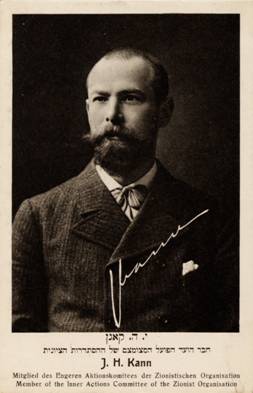
Jacobus Henricus Kann(Collection Jewish Historical Museum, Amsterdam).
At the same time, the family mingled freely with non-Jews, among whom were also members of the Dutch Parliament and ministers in the Dutch government. Kann engaged a non-Jewish partner to his bank – which he kept open on Shabbat – thus giving himself the opportunity to devote his time to other affairs: mostly Zionism, board memberships in the Jewish community and educational matters in The Hague.[6] The Kanns were closely associated with liberal Protestant Christian circles, in which the innovative educational ideas of Jan Ligthart and Prof. Rommert Casimir flourished.[7] They were personally acquainted with both.[8]Jacobus Kann was one of the founders of the Lyceum in The Hague, the first school of this type in the Netherlands. Anna Kann was an active suffragette, who promoted women’s right to participate in elections and be elected to the Dutch Parliament. The Hague branch of the Dutch Jewish Women’s Council was founded in the Kanns’ own residence.[9] Progressive views on equality, human rights and the international laws of nations were part of their social ethos. They were enlightened, modern people. Zionism probably saved them from further assimilation. It offered them a positive Jewish identity in a highly idealistic setting that was very similar to their other fields of activity.
When Kann heard that Theodor Herzl and David Wolffsohn were planning to set up a Zionist bank, he offered his professional skills, and Herzl came in person to meet with him in The Hague. Kann became a main player in the foundation of the Jewish Colonial Trust (1899) and served on its board until 1929. When the Anglo-Palestine Company (APC) – the banking subsidiary of the Jewish Colonial Trust – was incorporated, Kann was involved in the launching of its first branch in Yafo, in 1903. He also served on the Anglo-Palestine Company’s Board of Directors.
Kann’s political ideas were very close to Herzl’s. They were both bourgeois liberals, shaped by the 19th century. Both also were ‘political Zionists’, who sought the approval of the non-Jewish world before embarking on actual projects in Palestine. Nevertheless, Herzl and Kann did not develop a working relationship.[10]Kann as a banker was meticulous and slow. He would not engage in a venture unless a thorough research was carried out and a sound budget secured. Herzl had no patience for this. Consequently, Kann’s true rise within the Zionist Movement took place only after Herzl’s death in 1904. Kann, together with David Wolffsohn and Otto Warburg, constituted the Inner Action Committee that ruled over the Zionist Movement in Herzl’s place. He kept that position from 1905 till 1911, and it is during this period that Kann purchased the ‘Kerem Jabali’, north of Yafo.
The registration of ‘Kerem Jabali’ in Kann’s name, in 1906, had involved a question about Kann’s religion. It was not until the summer of 1909, when members of ‘Ahuzat Bayit’ started building on their plots, that the local Turkish authorities became aware of having been misinformed about Kann’s Jewish identity. They realized that Kann’s proxy in Palestine had given them an inaccurate answer to the relevant question. As the true purpose of the transaction became clear to them, they were infuriated, and filed a complaint with the Dutch delegation in Constantinople. The Dutch Ministry of Foreign Affairs disagreed with the Turks, and claimed that discriminating a Dutch citizen on account of his being Jewish was unacceptable. At that time, the Netherlands was represented in Palestine by an Italian delegate, who took the matter quite seriously. He even called upon the Dutch government to send a warship to the coast of Yafo in defense of Kann’s property.[11] The Dutch Ministry, however, contended that Kann was perfectly able to attend to his own business, and sure enough, the matter calmed down. The purchased land stayed in Kann’s possession until he sold it, in the years shortly after the incident, to the members of the ‘Ahuzat Bayit’ association.
During that period, Kann’s mind was bustling with ideas and plans. In financial matters, he was the absolute backbone of the Zionist Movement. In 1909, he met in person with a young accountant, who had only just established himself in Amsterdam.[12] His name was Eliezer Siegfried Hoofien. Kann talked him into a job with the Zionist Movement in Cologne. Several years later, in 1912, Hoofien became vice-director of the Anglo-Palestine Company in Yafo, under Zalman Levontin. By then, the bank had already established branches in Jerusalem, Beirut, Haifa, Hebron, Tiberias and Safed. Hoofien would not only stay on that job, but he eventually rose to Levontin’s position and became Director of the APC – in later years Bank Leumi, the bank he served until 1957. Kann’s initiative had been the starting point of Hoofien’s brilliant career.[13]
In 1910, Kann founded the first ‘hachshara’ organization in the Netherlands: the “Joodsche Tuinbouw-,Veeteelt-en Zuivelbereidingsvereeni-ging”, (Jewish horticulture, livestock farming and dairy processing association). That same year he also engaged the services of a civil engineer of the Dutch government by the name of A.A. Meijers, who had worked in Java for many years and was an expert in irrigation systems.[14]Meijers was charged with the task to design an irrigation project for the development of the Audja plain, situated along the banks of the Yarkon river between Yafo and Petah Tikva. The area’s proximity to Yafo made it ideal for orange plantations for export purposes. Betzalel Yaffe, one of the members of ‘Ahuzat Bayit’, was involved through his activities with an irrigation company.[15]Kann further instructed Meijers to design development plans for Jerusalem, not only in connection with its water supply, but also with electrical street lighting and… an electrical tramway. While in those days Jews were still moving from Eastern Europe to the United States, Kann rightly estimated that millions of Jews would eventually immigrate to Palestine. This, he felt, could only be realized by providing the scarcely populated and undeveloped Holy Land with viable workplaces and an appropriate western-style infrastruc-ture.
In spite of his enthusiasm, Kann also developed frustrations with the Zionist Movement – and those were typical Dutch frustrations. Kann, Hoofien, and later on also Siegfried van Vriesland and Nehemia de Lieme, who all held financial positions, each had their moments of despair about the administration of the Zionist enterprise.[16] Budget transgressions and money wasted on inefficient projects were a constant source of aggravation to them. Kann disapproved of philanthropy and expected projects to become self-sufficient and profitable as soon as possible. He strongly criticized the development projects in Kineret, Merhavia, Degania and other places. In those days, he used to impress his fellow Zionists in the world organization by knowing every single detail on every single project in Palestine. But his strong involvement also took a heavy toll on his health. In 1911, after his close friend David Wolffsohn lost his position in the Zionist Movement, Kann suffered a heart attack and left the Inner Action Committee together with Wolffsohn.
In 1913, Kann presented a confidential report to his co-members of the Larger Action Committee of the World Zionist Movement. In this document he stated that the “so-called practical work in Palestine” was suffering of “severe malformation.”[17] He supported his criticism by citing “facts and numbers” rather than supplying “theoretical explanations”, and proceeded to describe several projects. He finally declared that it was “not too late to prevent a total collapse” and concluded with a series of recommendations:
“All Zionist projects should be submitted to central control. Strict order is prerequisite in all our branches of activity. Budgets must be strictly abided by, and any excess should entail a penalty. An orderly bookkeeping should be introduced in all departments, and money belonging to different institutions of the Zionist Organization should be kept strictly apart.”
It was a language most Zionists did not understand. It merely succeeded in arousing their irritation.
Kann became once again very active during the First World War, when the Jewish National Fund was relocated to neutral The Hague. With the help of Dutch diplomatic channels, rescue money for the suffering Jews in Palestine was transferred to the Yafo branch of the Anglo-Palestine Bank, whose manager, Hoofien, had been appointed Dutch Consul. After the war, from 1918 until 1922, Kann served as Chairman of the Board of Directors of the Anglo-Palestine Bank. It was then that he paid his second visit to Palestine, in 1919, together with his wife and two of their five children. Also accompanying them was Jan Ligthart’s widow, Marie Lion Cachet, who was a Protestant Christian of Jewish descent.[18]Kann traveled to Palestine as member of the Zionist Commission, a first Jewish government-like authority in Palestine, which closely cooperated with the World Zionist Organization in London and was later replaced by the Jewish Agency. It was not long after the Balfour Declaration (1917). Those were uncertain years, in which the League of Nations still had to decide to whom the Mandate over Palestine should be handed. As far as Kann was concerned, it could have been the Netherlands.[19] Before his journey he had lobbied several Dutch government officials, including the former Minister of Foreign Affairs Dr. J. Loudon, but none of them had shown interest in the job.
During this second journey to Palestine, Kann attended several sessions of the Zionist Commission. On one occasion, he tried to convince Dr. Chaim Weizmann of the need to change the Zionist Movement’s approach towards the Arabs, who then constituted 90% of Palestine’s population.[20]Kann was well ahead of his time when he raised the issue, and was one of the first Zionists to recognize it as a problem. In view of his background and social environment in The Hague, Kann’s attitude was hardly surprising. Moreover, he was being true not only to himself, but to Herzl’s legacy as well: Arabs would form an integrated minority with full civil rights in a Homeland, in which the Jews would achieve an overall majority by mass immigration. Kann expressed his views on the Zionist Commission’s tasks in particular in the area of education. During the Turkish period, all inhabitants of Palestine had paid taxes, but Arabs were the only ones to enjoy subsidized education. Jews and others were in fact doubly disadvantaged, as they had to pay for their own education on a private basis. Now that the Zionist Commission would gradually take over Palestine – as they thought was soon to happen in those optimistic days – Kann advised the Commission to start a public school system in which Jews and Arabs, the Jewish Homeland’s future inhabitants, would learn together in both Hebrew and Arabic.[21] He in fact opposed the development of two separate nationalistic educational systems. But his highly idealistic views fell on deaf ears. Most Zionists paid no attention to the problem. For many years to come, Kann kept warning the Zionist Movement against the potential harm of its position vis-à-vis the Arab population.
Kann arrived to the country for a third time in 1924, this time not as a visitor, but to live there with his wife. He had been looking for a suitable way to make aliya, and was nominated by the Dutch authorities as Consul of the Netherlands in Jerusalem.[22] In 1925, her Majesty the Dutch Queen appointed him Knight in the Order of the Dutch Lion. However, in 1927, after spending three years in Palestine, the Kanns were forced to return to the Netherlands due to serious health problems.
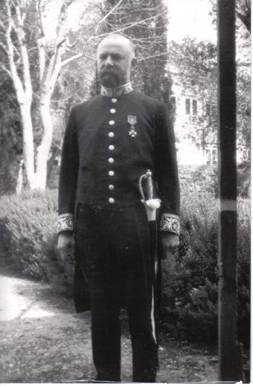
Kann in his uniform as Dutch consul in Jerusalem(Collection Kann family).
Life in Palestine did not change Kann’s moderate Zionist views, even though he was confronted with a British Mandate that largely built itself upon injustices inherited from the Turkish Empire. Kann personally experienced the disadvantage of Arab dominance in official functions in Jerusalem despite the fact that Jews had been a majority there for many decades.
As Dutch Consul he became involved with the inheritance of Jacob Israel de Haan.[23]Kann’s arrival in 1924 coincided with the year in which De Haan was assassinated by Zionist extremists striving to stop the latter’s anti-Zionist activities. The money left by De Haan to his legal wife Johanna van Maarseveen in the Netherlands was in the hands of the Arab family at whose residence De Haan had stayed, the Aweidas in Mamilla Street. He had loaned out the money to them. As they had no liquid funds to repay the loan, they were compelled to sell part of their property – “a house in the Birket Mamilla Street comprising two stories of flats, five shops and a garden”. Kann himself purchased the property and began collecting rent payments from the tenants. Johanna van Maarseveen could be satisfied. After a while, the Aweida family started legal proceedings, and Kann eventually lost the case in a court hearing that was dominated by Arab judges and contested only by the British court member. The sale was nullified on the grounds that proper enquiry about the annual rent payments had not been made. As a result, Kann lost both the property and his money. This all happened on the eve of Kann’s return to the Netherlands, in 1927. Kann’s successor, Siegfried van Vriesland, ended the affair through diplomatic channels involving the Dutch and the British governments, claiming that the British had been negligent towards Kann. In the end, Kann was paid compensation by the British.[24]
Even this episode did not change Kann’s liberal ideas. In 1928, when the Zionist movement became disillusioned about the likelihood of Jewish mass immigration to Palestine, Kann declared:
“Palestine is a country with an Arab majority. For the time being, it seems improbable that the vision of a Jewish State or a Jewish majority can be realized. But we will lose nothing by leaving it to the future to determine which nationality will finally have the majority.” [25]
“Excluding the Arabs from Palestine”, an alternative pursued by the more desperate Zionists, was in his eyes “a folly”. Nevertheless, Kann remained fully committed to the concept of Palestine as Jewish Homeland. He believed that the Arabs would eventually have to come to terms with this ideology, not by coercion but by peaceful means. In his words: “We need to be patient and alert at the same time.”
After the bloody Arab riots of 1929, Kann fiercely criticized the British administration for building up an exclusively Arab police force, while leaving the Jews unprotected and even disarming them.[26] But at the same time he once again condemned the “chauvinistic elements in Zionism”, and he voiced his endorsement of the ideas of Magnes.[27] Judah Magnes, the first president of the Hebrew University of Jerusalem, was a follower of Ahad Ha’Am and an ardent pacifist. Magnes, along with Martin Buber and other prominent intellectuals, actively supported the Brit Shalom group, an organization striving for peaceful Jewish-Arab coexistence in a bi-national state. There is no doubt that both Jacobus Kann and Siegfried van Vriesland sympathized with this group.[28]
Tragically enough, both Jacobus and Anna Kann were murdered by the Nazis. They perished in Theresien-stadt, he in 1944 and she in early 1945. Kann did not live to hear the reading of the Declaration of Independence by David Ben-Gurion in Beit Dizengoff. But the words contained in it regarding the non-Jewish minorities in the Jewish State were completely in line with the principles of this enlightened, liberal Dutchman, who was an enthusiastic and yet moderate Zionist.
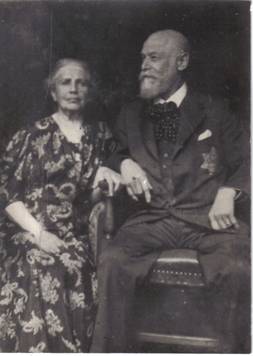
Jacobus and Anna Kann during the Nazi-regime in the Netherlands (Collection Kann family).
[1] Burstein, E., “Was Tel Aviv founded in the Netherlands?” in: Private Banking, no. 75, April 2009 (Bank Leumi). In Hebrew: <www.achuzatbait.org.il> בורשטיים, איתן, "האם תל אביב נוסדה בהולנד?"
[2] Kann, J.H., Erets Israël, Het Joodsche Land(Leiden 1908), p. 7.
[3] Vladimir Jabotinsky tried to prevent its publication, out of fear that Kann’s statement would cause political harm to Zionism in the Ottoman capital, Constantinople.
[4] Kann, J.H., Erets Israël, Het Joodsche Land(Leiden 1908), p. VII.
[5] Eliav, M., “Jacobus Kann as a Zionist Leader”, in: Michman, J. and Levie, T. (eds.), Dutch Jewish History (Jerusalem 1984), pp. 491-508; Giebels, L., De zionistische beweging in Nederland 1899-1941 (Assen 1975).
[6]Biografisch woordenboek, Joden in Nederland in de twintigste eeuw, pp. 163, 164.
[7] Klinken, G.J. van, “Van ‘Land der Vaderen’ tot ‘Erets Israel’, Twee Palestijnse reisbeschrijvingen uit de familie Lion Cachet”, in: Broeyer, F.G.M. en Klinken, G.J. van (eds.),Reizen naar het Heilige Land, Protestantse impressies 1840-1960 (Zoetermeer 2008), pp. 119-123.
[8] Ligthart’s widow traveled with the Kann family to Palestine in 1919 (see Van Klinken), and Prof. Rommert Casimir visited Palestine in 1928, CZA A121/114.
[9] Boas, H., Bewust-joodse Nederlandse vrouwen (Kampen 1992), p. 116.
[10] Eliav, pp. 494, 495.
[11] Giebels, p. 90.
[12] CZA A121/77.
[13] Efrati, N., “Eliezer Siegfried Hoofien, Director of the APC: His Role with the Yishuv during World War I and its Aftermath”, in: Michman, J., (ed.), Dutch Jewish History, II (Jerusalem 1989), pp. 219-234.
[14] CZA A121/1. Java was part of the Dutch colony ‘Dutch India’, now Indonesia.
[15] CZA A121/12.
[16] Brasz, C., “Dutch Jews as Zionists and Israeli Citizens”, in: Brasz, C. and Kaplan, Y. (eds.),Dutch Jews as Perceived by Themselves and by Others (Leiden 2001), pp. 215-234.
[17] CZA A121/12.
[18] Van Klinken, pp. 113-121.
[19] CZA A121/184.
[20] Giebels, p. 129; Van Klinken, p. 115; CZA A 121/31.
[21] CZA A121/31; See also: Giebels, p. 129; Van Klinken, pp. 115, 116.
[22] Giebels, L., “De Nederlandse Consulaire vertegenwoordiging in Palestina van 1918-1940”, in: Studia Rosenthaliana, V, no.1 (1971), pp. 71-101.
[23] CZA A121/114.
[24] Idem.
[25] CZA A121/115.
[26] Kann, J.H., Opmerkingen betreffende het beleid van de Mandaatsregeering van Palestina met betrekking tot de Arabische overvallen op de Joodsche bevolking in augustus 1929 en betreffende de Joodsche en de Arabische volksgroepen, (Den Haag 1930).
[27] Idem, p. 60. He referred to a brochure Magnes published in 1930 under the title Like all the Nations?
[28] On Van Vriesland, see: Siegfried van Vriesland, May 2nd, 1886-December 4th, 1939, (Jerusalem 1940).
Tel Aviv, Beth Dizengoff, 1.6.2009
